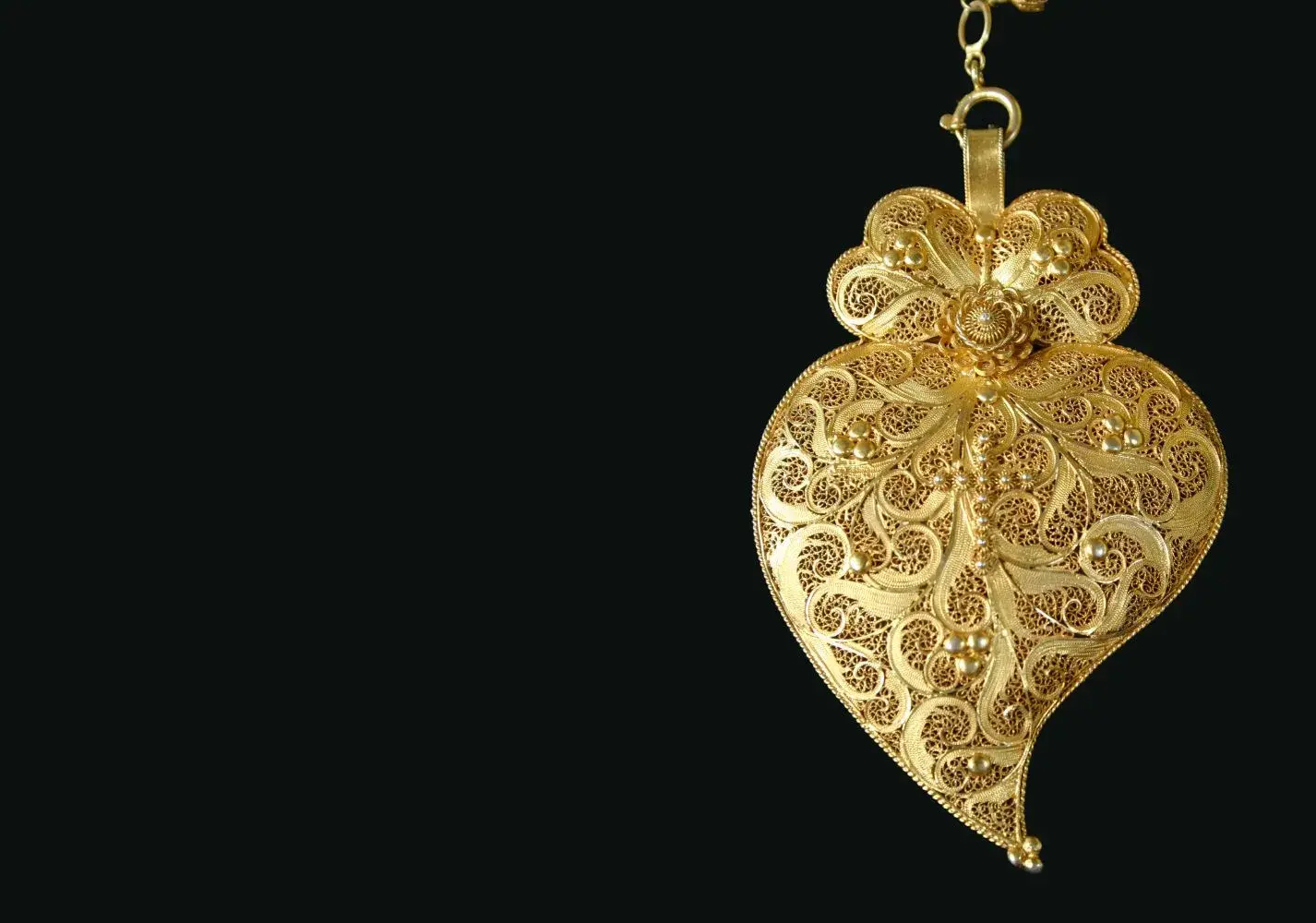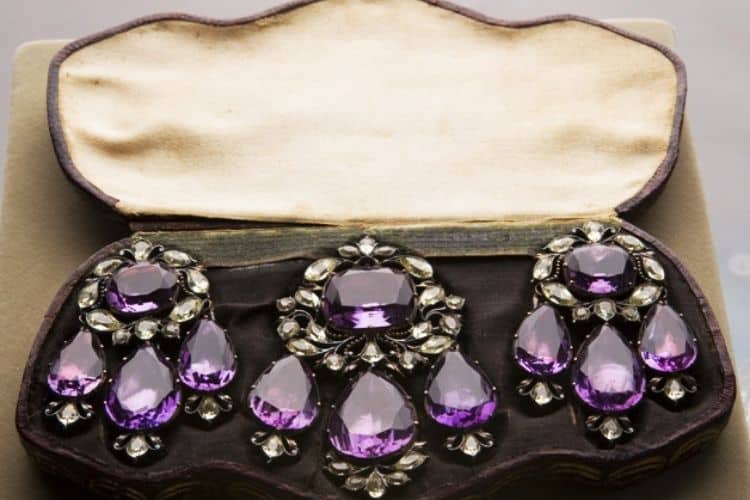10 de August, 2023

Portuguese filigree, as well as Portuguesejewelry as a whole, mirrors the country’s history and culture, extolling artistry, beauty and originality. Portuguese gold jewelry is globally acclaimed for its excellence, embodying the nation’s cultural and artistic heritage. An example is the distinction of the filigree technique as an intangible heritage of humanity by UNESCO since 2019, a testimony to its unique artisanal nature. Portugal also stands out for its use of 19.2 carat gold. This surpasses conventional 18-carat gold in quality.
In this article we will tell you some curiosities about Portuguese jewelry (or joalharia, as they say in Portugal). We will tell you about its history and use in religious and traditional pilgrimages in the country. Discover how Portugal celebrates its cultural heritage in contemporary pieces through the work of current jewelers. And finally, get to know the Feast of Nossa Senhora da Agonia, the most traditional celebration of gold in Portugal, which takes place every year in August in Viana do Castelo.
WANT TO LIVE IN PORTUGAL? CLICK HERE TO CONTACT US >
The jewelry tradition in Portugal has its roots in the Age of Discovery. During this era, the wealth brought by the Portuguese trade routes allowed the creation of a noble class that valued ostentatious jewelry as a symbol of status and power. It was common to import jewelry and luxury objects from other territories, especially the Orient and England.
In the 17th century, Portuguese jewelry is divided into two distinct phases. The first, until the 1640 s, can be characterized as an extension of the Renaissance style, showing works of jewellery in polychrome, either in gems or enamels. In the second phase, the presence of pieces with rose-cut diamonds, adorned in gold and silver, as well as emeralds, rubies and sapphires stands out. Among men’s jewelry, feathers stood out as hat ornaments, often enriched with precious stones. Hats also featured the “sentillo“, a small chain that adorned the crown (composed of a toe cap, passementerie or chain and buckle).
In addition, rings were widely worn by both men and women. They varied in materials: diamonds, traditional rubies, sapphires, emeralds and even hyacinths, crystals, miniatures, aquamarines, cat’s-eyes, turquoise and coral. The Renaissance tradition of cameos is also noteworthy at this time.
In the 18th century, the Portuguese jewelry tradition reached its apogee, with the emergence of jewelry schools in Lisbon and Porto. The Baroque period influenced the creation of exuberant ornaments, with ornate motifs inspired by nature, religious themes and grandeur. Jewelry production continued to expand during the 19th century, with the introduction of new techniques and materials, such as filigree and enamel, which are still widely used today.
In the 19th century, the Industrial Revolution brought modern technologies, impacting production techniques. In addition, historical events such as the reign of Queen Mary II influenced the aesthetics of the pieces, evolving into a balance between royal tradition and contemporary styles.
In the 20th century, Portugal’s jewelry scene embraced a harmonious blend of tradition and innovation. Modern schools of jewellery emerged, nurturing a new generation of artisans who drew inspiration from the country’s rich history and contemporary global trends. The quest for personalization, along with the revitalization of ancient techniques such as filigree, reflects a renewed appreciation for heritage while responding to modern demands.
Also get to know the award-winning highlights of Portuguese gastronomy
A filigree is a silversmithing technique that consists of creating delicate, intricate patterns from twisted and interwoven strands of metal, which are welded together to form intricate, detailed designs.
The technique has been used since Greco-Roman antiquity. However, it was improved in Portugal over the centuries, with the introduction of new applications and materials, especially in the far north of the country, in the cities of Gondomar and Viana do Castelo. Today, Portuguese filigree is recognized worldwide as one of the most sophisticated and refined techniques of national jewellery and a symbol of Portugal. Many Portuguese jewelers continue to use it in their creations, keeping this tradition alive.
In the past they were made only in gold, but nowadays gold-plated silver is widely used, reducing the value of the piece by about 20 times and popularizing it even more.
The popularity of Portuguese filigree has also been driven by personalities from the world of fashion and entertainment, who use the technique in their creations or who are often seen wearing Portuguese filigree jewelry. This is the case of Hollywood actress Sharon Stone who has been photographed a few times wearing her “Heart of Viana in Filigree”.

The Coração de Viana is an iconic model of Portuguese filigree, known for its reproduction of a heart turned to the left side with lacy details inside. This model is a tribute to the Sacred Heart of Jesus.
The Contas de Viana, on the other hand, are small balls decorated with Portuguese filigree ornaments that give rise to eternal jewelry that passes from generation to generation. Due to their lightness and hollow construction, Viana Beads were more economical and quickly became the most popular jewelry of Portuguese Popular Gold. Young women would buy the beads one by one with the money they could collect from their work. The beads were placed on an adjustable woolen thread with a pompom at the back; a collection that grew over the years.
The Queen Earrings are another classic model, inspired by the earrings worn by Queen D. Maria II (1819-1853) during a visit to the city of Viana do Castelo. From then on, the noble ladies of the time started wearing the same model, not only for its beauty but also to demonstrate their status and wealth. To this day, powerful women wear the piece, such as Princess Mary of Denmark and Queen Letizia of Spain.

One of the most beautiful and rich scenarios of the Portuguese popular tradition can be contemplated during the
Pilgrimage of Our Lady of Agony, in Viana do Castelo
. The Agonia Festival usually lasts 4 days in August. The highlight of the pilgrimage takes place at the Parade of Stewardship, the largest open-air showcase of costumes and gold in the country, where around 600 participants show their pride by wearing the traditional costumes of Viana and using all the gold in the family. The ostentation is such that there is a whole security scheme prepared by the local police during the days of the party. The photos speak for themselves.
The golden ornaments appear on the neck, ears, or arms, or in accessories known as “peitilhos”, a kind of cloth bib where all the gold you want to show off is baked. The queen earring is the most common ear adornment used in the party.

Anyone who has ever visited an exhibition of Portuguese jewelry belonging to Portuguese nobility and wealthy merchants has surely noticed the large amount of precious and semi-precious stones used in the creations.
During the colonization of Brazil by the Portuguese, several precious stones were discovered in the territory, including diamonds, emeralds, rubies and sapphires. From the 18th century onwards, Portugal became one of the main gemstone trading centers in the world, receiving a large amount of Brazilian stones that were cut and transformed into jewelry in the city of Porto.
Brazilian stones are highly valued in Portuguese jewelry to this day, and many Portuguese designers and jewelers use these stones in their creations, combining the beauty of Brazilian stones with the refined technique and design of Portuguese jewelry.
We recommend a visit to the Marta Ortigão Museum in Porto, which brings together a collection of about 300 pieces from the late 17th to the 20th century that belonged to the maternal niece of the Portuguese painters Aurélia de Souza and Sofia de Souza.

We cannot fail to mention the strong relationship between the Catholic religion and gold ornamentation in religious manifestations in Portugal. Gold is used to decorate sacred images, litters, procession participants and extras, and it was common until the mid-twentieth century for the women behind the litters to be laden with gold (such as the mordomas of the Agony Festival).
You can also find beautiful goldwork on liturgical pieces in the country’s sacred museums.
Portugal also has several churches with richly ornamented gold walls, such as the Churches of São Francisco and Santa Clara in Porto and the Church of Madre de Deus in Lisbon.

Carlton Jewellery is a Coimbra-based jewelry brand that unites Portuguese tradition and culture with the art of jewelry. Founded in 2016 by Portuguese jeweler Carlos Góis, the brand has always stood out for its high-quality collections, which are a true celebration of Portuguese culture.
Carlton Jewellery’s engagement ring collection is a tribute to the magnificent Portuguese palaces, full of beauty and romance. Each model is inspired by one of these buildings:
Carlton Jewellery’s lifestyle line, on the other hand, brings together through the Lisbon and Leaf collections, both linked to Portuguese culture. The Lisbon collection is a tribute to the capital’s rich cultural heritage. Each piece is skillfully designed to capture the essence of Lisbon’s beauty and history. The intricate details and elegance of the pieces reflect Lisbon’s iconic architecture. The tiles are represented here by the enamel effect used on the pieces, which carry within them the vibrant atmosphere of the city. If you are looking for jewelry that expresses sophistication and cultural significance, Carlton Jewellery’s Lisbon collection is a remarkable choice.
On the other hand, the Leaf collection is a celebration of nature and its timeless beauty. Inspired by the majestic simplicity of leaves, each piece is an artistic representation of natural harmony. The delicacy of the leaf designs and the attention to detail make these jewels an elegant expression of the connection between humanity and mother nature. If you are looking for pieces that exude serenity and an organic touch, the Leaf collection by Carlton Jewellery is sure to captivate lovers of nature and art in jewelry.
For those looking for exclusivity and description, Carlton Jewellery offers a customized service, including online. Through a video call or face-to-face visit, it will be possible not only to know the pieces of the collections mentioned above, but also to order exclusive and tailor-made jewelry, with the guarantee that your piece will not be replicated for anyone else.
Atlantic Bridge clients have preferential and personalized service, with extended hours. Just send an email to c.gois@carltonjewellery and inform that you are a client of Atlantic Bridge to schedule your visit or video call.
Atlantic Bridge, through Atlantic Lovers is a partner of the jeweler and recommends its collections to all who seek products with originality and exceptional quality.


Author:
Atlantic Bridge